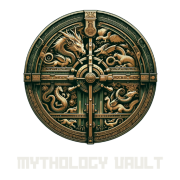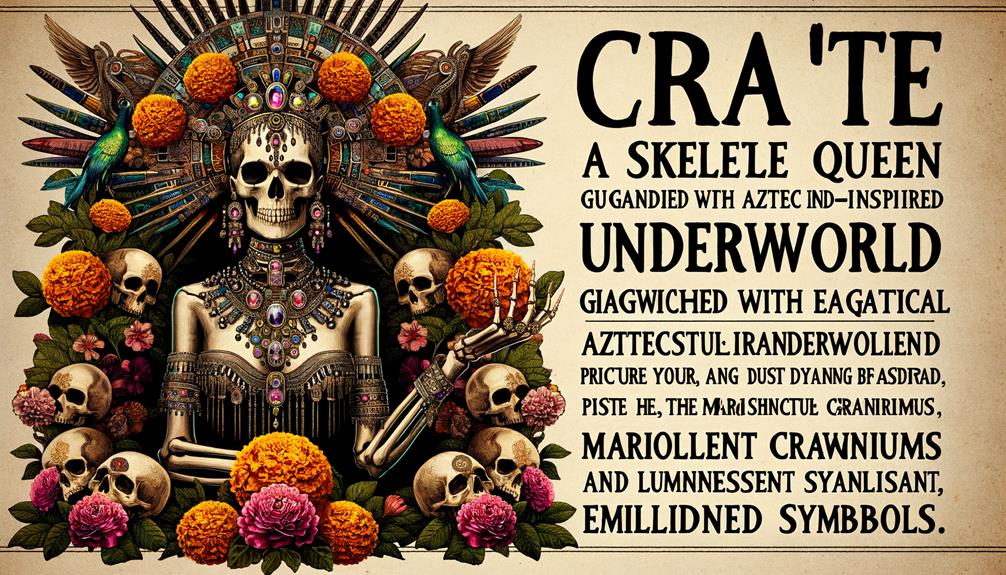With her skeletal features, Mictecacihuatl embodies the profound connection between existence and mortality. In Aztec legends, she guides souls through Mictlan's perilous nine levels, overseeing the cycles of decay and rebirth. This wise mentor's role highlights her significance in maintaining cosmic equilibrium. Interestingly, her influence transcends ancient myths, still resonating in modern observances like Dia de los Muertos. Exploring her enduring symbolism might unearth deeper insights into our shared human experience.
Origin and Mythology
Mictecacihuatl's divine status began with her sacrifice as a newborn, forever marking her destiny as the esteemed Queen of the Underworld in Aztec mythology. As the goddess overseeing death, she reigned over Mictlan, the underworld, alongside her partner, Mictlantecuhtli. Her transformation from mortal to immortal exemplifies the archetypal journey of a hero, where sacrifice leads to transcendence and eternal guardianship.
In Aztec beliefs, Mictecacihuatl personified the divine feminine, a potent force guiding souls through the nine underworld realms. She protected the bones of the deceased, essential for the cycle of death and rebirth. This cycle manifested in Quetzalcoatl creating new races from these bones, underscoring life and death's interconnectedness.
Mictecacihuatl's influence persists, especially during Day of the Dead festivities. As the Lady of the Dead, she's honored for maintaining balance between the living and deceased. Her legacy as the Lady of the Underworld remains a poignant reminder of mortality and divinity's sacred interplay.
Role in Mictlan

At Mictlan's core, the Underworld's ruler shepherds souls through nine demanding trials, compelling them to confront and overcome obstacles en route to eternal rest. This path, rooted in Aztec legends, mirrors the archetypal hero's journey – each soul must navigate tests probing their essence. Mictecacihuatl's duty transcends mere oversight; she offers indispensable guidance to those traversing the underworld.
The Aztecs believed one's manner of death determined the afterlife destination, yet Mictecacihuatl ensured souls faced trials with dignity. Her presence symbolized life and death's cyclical nature, a recurring motif in Aztec cosmology. The bones amassed by Mictecacihuatl and her consort Mictlantecuhtli weren't just remains – they were seeds for rebirth, affirming existence's enduring cycle orchestrated by Quetzalcoatl.
Her stewardship through Mictlan was both arduous and reassuring, embodying mythology's sagacious mentor archetype. She guaranteed each soul's deathly voyage contributed to life's grander cycle, fulfilling their ultimate purpose.
Cultural Significance
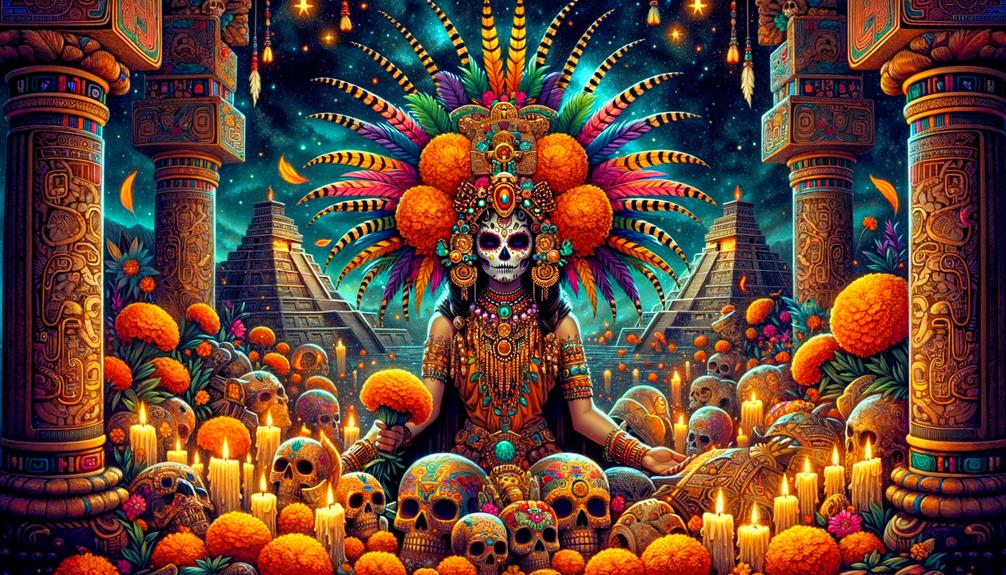
Mictecacihuatl symbolized the eternal cycle of life and death in Aztec culture, a stark reminder of our mortality yet also the promise of rebirth. As ruler of the underworld alongside Mictlantecuhtli, she guided souls through the nine perilous levels of Mictlan to their final resting place.
Her skeletal appearance adorned with bones and flowers embodied the duality of decay and renewal. Her role transcended mere finality, representing the sacred passage where death upholds life's cyclical nature.
Mictecacihuatl's influence persists in the Day of the Dead celebrations across Central America, where families honor deceased loved ones, blending ancient Aztec rites with modern Mexican traditions. Through this ritual, her legacy endures, promoting the acceptance of mortality and the beauty of rebirth.
In Aztec mythology, no sacrifice went unnoticed by Mictecacihuatl, ensuring the harmonious balance between death and life remained intact.
Modern Depictions
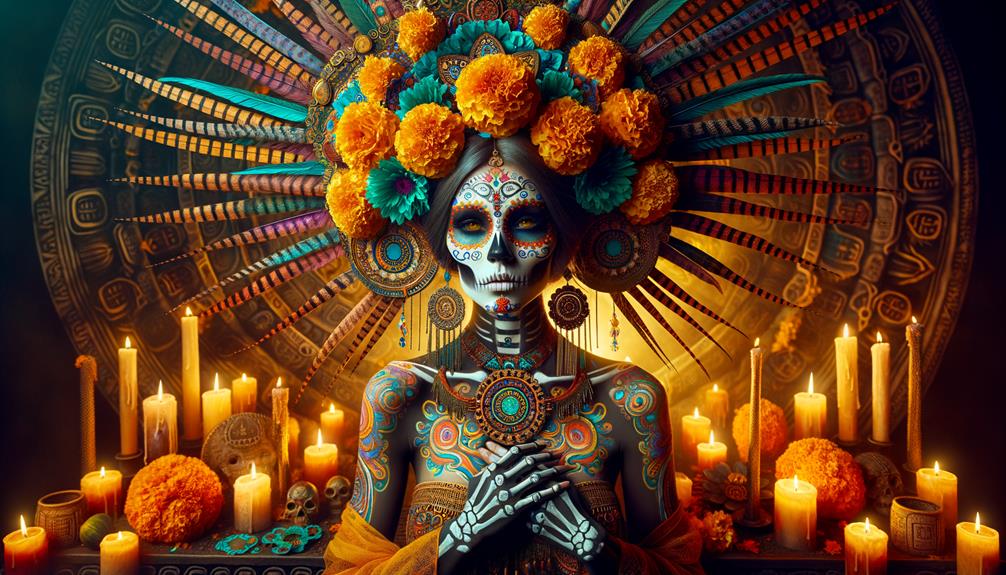
Modern portrayals breathe vitality into Mictecacihuatl's legend, depicting her as a formidable, otherworldly presence bridging past and present realms. Contemporary interpretations often show her as a tall, stunning woman with dark skin, golden brown eyes, and flowing black hair. Her elaborate headdresses and symbolic facial paint honor her divine connection to death in Aztec belief.
Artists frequently adorn her in sacred red and gold garments, colors representing her celestial status and role in the underworld. Her abilities, including shapeshifting, flight, and immortality, reinforce her position as the eternal death goddess. These depictions capture her essence as both a soul's guardian and collector, tasked with gathering the bones of the deceased alongside her husband, Mictlantecuhtli.
In myth, Mictecacihuatl's journey spans dimensions, linking the underworld's first level to the earthly plane. Modern art and media celebrate her beauty and might, embodying the souls she oversees and the profound mysteries of death in Aztec culture. These contemporary works ensure her enduring legend transcends time and space.
Symbolism and Iconography
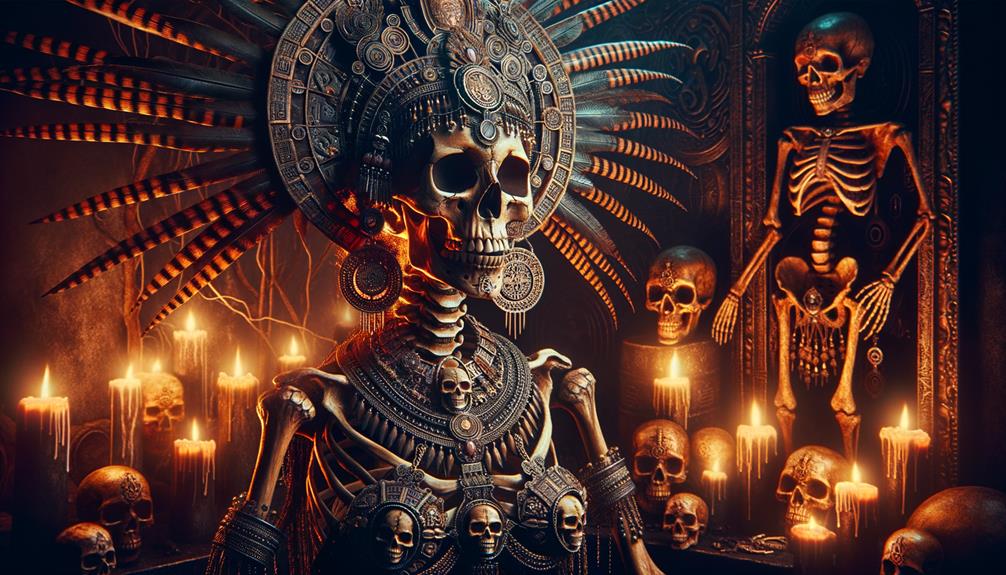
Symbols surrounding Mictecacihuatl offer insight into Aztec perspectives on mortality and renewal. Her skeletal visage starkly depicts death's inevitability, aligning with perspectives even devout Christians understand.
Mictecacihuatl's serpent skirt represents life's fleeting nature, reminiscent of Norse serpent imagery signifying cycles of destruction and rebirth. Her open jaws, prepared to consume stars, convey her role as a psychopomp shepherding souls through the underworld. This image resonates with those grieving loved ones, providing comfort through continued connection.
Moreover, her sagging breasts symbolize fertility persisting amid decay, an archetype spanning cultures. This duality poignantly reflects the experiences of those who perished in childbirth, highlighting the intrinsic relationship between life and death.
| Symbol/Feature | Significance | Cultural Ties |
|---|---|---|
| Skeletal body/skull | Mortality and the afterlife | Aztec religion |
| Serpent skirt | Life's impermanence | Norse mythology |
| Open jaws | Guiding souls of the deceased | Continuity with deceased kin |
| Sagging breasts | Fertility amid decay | Death and rebirth across cultures |
These potent symbols illuminate the Aztec worldview, offering profound meditations on death's role within the cycle of existence.
Frequently Asked Questions
Why Did Aztecs Worship Mictecacihuatl?
The Aztecs revered Mictecacihuatl as the powerful deity guiding souls through the afterlife's maze. Her skeletal form embodied the cyclical nature of life and death, an archetypal force overseeing transformation. Worshipping her ensured navigating the underworld's path to the final resting place.
Who Is the Goddess Mictecacihuatl the Lady of the Dead?
Mictecacihuatl, the Aztec Goddess of Death, guides souls through the afterlife's challenges, representing mortality's inevitability. Her archetype symbolizes the transition from life to eternal rest, a journey every soul must undertake. This powerful deity oversees Mictlan, the underworld realm, ensuring the departed find solace after facing trials. Her presence reminds us that death is an inescapable part of existence, but one that can lead to profound peace.
Who Was the Queen of the Underworld in the Aztecs?
A soul embarks on a perilous trek across nine treacherous realms. Mictecacihuatl, the Aztec goddess of death, guides them, embodying mortality's transformative essence as the archetypal gatekeeper, ensuring their transition and eternal repose.
Who Is the Female God of Death in the Aztec Empire?
Mictecacihuatl, the Aztec goddess of death, acts as a spiritual guide for souls navigating life's inevitable challenges. Her archetype represents the arduous journey to find eternal rest, leading souls through Mictlan's trials and symbolizing the perseverance required to overcome life's difficulties. This powerful deity holds a prominent role in Aztec mythology, embodying the universal experience of mortality and the resilience needed to confront it.
